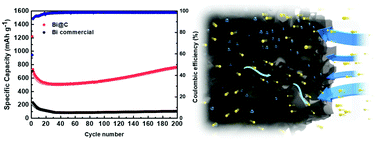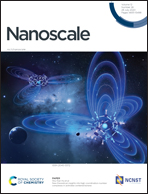Bi-MOF derived micro/meso-porous Bi@C nanoplates for high performance lithium-ion batteries†
Abstract
Micro/meso-porous Bi@C nanoplates are synthesized by pyrolyzing Bi-based metal–organic frameworks (MOFs) prepared by a microwave-assisted hydrothermal method to overcome huge volume expansion and pulverization of anode materials during battery operation. The Bi@C nanoplates are composed of ∼10–50 nm Bi nanoparticles in an amorphous carbon shell. The material shows very high capacity (556 mA h g−1) after 100 cycles at 100 mA g−1 and good cycling performance. Moreover, the Bi@C nanoplates perform well at high current densities and have excellent cyclic stability; their capacity is 308 mA h g−1 after 50 cycles and 200 mA h g−1 after 1000 cycles at 3000 mA g−1. The outstanding performance of this anode is due to the nanosized Bi and amorphous carbon shell. The nanosized Bi reduces the diffusion length of Li ions, while the amorphous carbon shell improves the electrical conductivity of the anode and also restrains the pulverization and aggregation of the metal during cycling. The proposed hierarchical micro/meso-porous materials derived from MOFs are a new type of nanostructures that can aid the development of novel Bi-based anodes for LIBs.

- This article is part of the themed collection: Nanoscale 2021 Lunar New Year Collection


 Please wait while we load your content...
Please wait while we load your content...